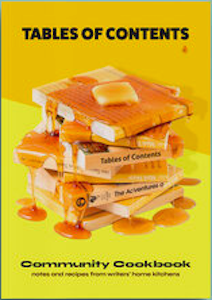
Cooking Thịt Kho, and Remembering What it Means to Be Vietnamese
Abbigail N. Rosewood Shares Memories of a Childhood Favorite
(and the Recipe!)
I left Vietnam at an age too young to have inherited recipes. I didn’t know then that we were moving—I was told that I would be studying in a summer program in Singapore and expected to return by the end of the season. I took few things with me, a couple of well-worn outfits and a good stack of Doraemon, a popular manga series at the time. By age eleven, I’d begun losing my birth country, not only the past, but losing forward all the times I would have spent with my grandparents, or circling around my nanny as she busied in the kitchen hacking beef into smaller bits using a butcher knife too large for her, churning soybeans into delicious milk, having her feed me another spoonful of ground turmeric and bee pollen as a cure for all my ailments. Loss is future tense. Everything that was once possible, a continuum of existence, the things I counted on to repeat themselves, have become memories.
My memories of food are rich and abundant. But it wasn’t until I was a freshman in college that I attempted to cook. Vietnamese food has always seemed difficult to make, intimidating for a novice. I learned to make stuffed pasta shells long before I dared to handle fish sauce—the most crucial ingredient in Vietnamese cooking—in the kitchen. In the 2000s, it wasn’t yet second nature to google, to turn to the Internet for answers before one ever finished formulating the question. Now, the blank search bar helps us to conceive of inquires we hadn’t realized we wanted to know. As a result, my pre-Internet-self had reconstructed the recipe I’m now sharing with you entirely via the quicksand of memories.
Standing by the stove, I stir the pork stew with a spatula instead of long wooden chopsticks like my nanny would have done. I add a little more fish sauce, a generous pinch of pepper, a splash of coconut water. Everything I’m doing is intuitive⎯a mere guess, the aroma guiding me. Wherever I am, in my college dorm kitchen, in my apartment in Brooklyn, the space erupts with memories⎯my grandfather sitting across from me, his perpetual tan, the steam of fresh, fluffy rice my nanny handed us in palm-sized ceramic bowls, the drone of soccer in the background, sports and news being the only two channels my grandfather was interested in.
Above, long tubes of fluorescent bulbs casting a bluish hue over us, its honest and unflattering truth a widespread choice in many Asian households, instead of the warm yellow lights preferred in America. I’m alone in the kitchen, but it doesn’t matter, the simulacrum is enough to make me tremble. This recipe is an approximation, of landscape, people, language, and of love too. It has survived translation, forgetting, my own underestimation of how much I could recall. It is born of both happiness and desperation, my teetering on the edge of what it means to be Vietnamese, and how to do so.
Loss is future tense. Everything that was once possible, a continuum of existence, the things I counted on to repeat themselves, have become memories.
Being Vietnamese is in the body. When I eat, I’m more Vietnamese than when I run on the treadmill, a decidedly non-Vietnamese activity. When I eat, I’m more Vietnamese than when I HBO Max & chill, or when I read, all the books being in English. At the table, I have none of the grace of Western dining etiquette. I eat with my legs crossed on the chair, using my fingers as utensils as much as possible, belching loudly to express/enhance satisfaction. I have long hair and don’t often tie it up, except when I eat and exercise, both activities requiring muscular concentration.
In 2013, I developed a chronic condition that prevented me from digesting sugar normally. The recipe, which excludes the caramelized sugar, has been adapted to suit my current lifestyle. It is sugar-free and still decadent. My fiancé encourages the making of this dish by sharing in my happiness, getting me fresh pork belly directly from farm stands. The meat quality is sublime, and we do not shy from gulping down thick slabs of pork skin and fat. In our relationship, he’s often the cook, though this recipe is one of the few offerings I can contribute, a tangible way for me to open a door to my childhood without the need for language and me losing track of myself through translation. I can show him: I was once this, only this, these flavors, this way of life.
Loss is future tense, but I gain by remembering. So much of Vietnam is forever lost to me, until I’m enveloped with the taste of home. For a moment, there is no distance between then and now, New York and Vietnam, absence and love, who I would have been had I not left⎯all possibilities existing simultaneously. Not an approximation, but occurring. Wherever I am, I’m still a girl enjoying a meal with her grandfather.
Sugar-Free Thịt Kho (Vietnamese Braised Pork Stew)
Ingredients
2 lbs pork belly cut into 2-inch cubes
6 hard-boiled eggs
3-4 cups of chicken/beef broth or bone broth
1 tbsp coconut water
3 tbsp fish sauce
1 tbsp soy sauce
Pinch of pepper
Pinch of umami/mushroom powder (optional)
1 yellow onion cut into large chunks
1 minced scallion
3 medium-sized potatoes chopped into small chunks
Instructions
Boil eggs for 6 minutes. Drain, submerge in cold water, and peel. Cut pork into chunks. In a medium pot, sear pork and onion for 1 minute. Add broth into the pot. Add water if necessary to fully submerge the pork. Add soy sauce, fish sauce, coconut water, to the pot. Turn heat to high. When it hits boiling point, turn the heat down and let it simmer uncovered for about 2.5 hours. Make sure that the liquid doesn’t evaporate completely. You want to have a good amount of sauce at the end. Add more broth or water if necessary as it cooks. During the last 40 minutes of cooking, add hard-boiled eggs and potatoes to the pot. Garnish with scallion and pepper. Serve with rice and a side of kimchi or any kind of fermented vegetables. Enjoy!
_________________________________________________

The Tables of Contents Community Cookbook is available now via Tables of Contents. You can also find it at indie bookstores including Books Are Magic, McNally Jackson, Now Serving LA, and Omnivore Books.
*
The Tables of Contents Community Cookbook is a collection of notes and recipes from the home kitchens of 36 contemporary poets, essayists and fiction writers. Contributors include Alexander Chee, Carmen Maria Machado, Idra Novey, Tommy Pico, Emma Straub, Angela Flournoy, Nick Flynn, Nafissa Thompson-Spires, Pitchaya Sudbanthad, Leanne Shapton, Paul Lisicky, and two dozen other leading contemporary authors.
Tables of Contents uses food to create unexpected experiences and conversations around literature, art, music, and culture. Founded in 2012, TOC has produced literary-inspired dinners from New York to Mexico City, hosts a monthly reading series pairing snacks with authors’ texts, and recently launched its monthly newsletter A WINNING CAKE. Learn more at tablesofcontents.org, on Instagram at @tables.of.contents, and Twitter @tblsofcontents.
Abbigail Nguyen Rosewood
Abbigail Nguyen Rosewood was born in Vietnam, where she lived until the age of twelve. She holds an MFA in creative writing from Columbia University and lives in Brooklyn, New York. Her debut novel, If I Had Two Lives, has been hailed as “a tale of staggering artistry” by the Los Angeles Review of Books and “a lyrical, exquisitely written novel” by the New York Journal of Books. The New Yorker called it “a dangerous fantasy world” that “double haunts the novel.” Her short fiction and essays can be found at Electric Lit, Lit Hub, Catapult, The Southampton Review, The Brooklyn Review, Columbia Journal, and The Adroit Journal, among others. In 2019, her hybrid writing was featured in a multimedia art and poetry exhibit at Eccles Gallery. Her fiction has been nominated for the Pushcart Prize, Best of the Net, and Best American Short Story 2020. She is the founder of Neon Door, a forthcoming immersive literary exhibit.



















